In my Home
'patch' in the Northeastern USA, pre-sunrise vocalization of birds or dawn
chorus begins around the vernal equinox. With warmer temperatures and the approaching
breeding season, resident birds begin to sing half-hour to an hour before
sunrise. From mid-April to mid-May, summer migrants join the chorus. The dawn
chorus begins to fade in late August and ends by the beginning of September.
Dawn chorus has
been studied for hundreds of years [1] and reviewed recently [2, 3]. The
motivations for dawn singing may be divided into three different classes. The first
set is related to the breeding cycle; hormone levels, mate attraction,
communications with mates and nestlings, and territorial defense. The second
set is safety and food availability; low light levels for minimizing predator
attacks, fixed perches to avoid detecting movements, sharing of food source
information, social interactions within species and across species. The third
set is environment related; low noise and better sound transmission, sky
conditions, temperature, and humidity levels favorable for vocalization.
Songbirds or
passerines of the order Passeriformes are the main participants in the dawn
chorus. Each species may have many different vocalization patterns. Typically,
songs comprise phrases composed of one or more syllables and often repeated at
regular time intervals. Calls are short, simple notes used for communications
such as predator alarms, 'I am present', and 'Here is food'.
Singing in most songbird species is attributed to males although some females
may also sing specially during breeding season. Many other species also
vocalize before sunrise - a flock of Canada Geese in flight honk, Barred Owls
hoot and Mourning Doves coo.
The clock time at which each species initiates vocalization
has been correlated with light intensity and their eye size. In a study
conducted in United Kingdom, Portugal and Switzerland, birds with larger eye
size and body mass are reported to initiate singing earlier [4]. Other reports
also conclude that ambient light levels affect the singing behavior of
songbirds [5, 6].
We examined these hypotheses on the observations made in the Home
'patch'. Dawn singing was clearly related to the nesting period. We understand that the composition of
a dawn chorus may vary largely with habitat variations even within the same
geographical area. This makes it difficult to generalize bird behavior based on
a limited number of individuals. However, the fact that some individuals were
observed to begin singing at a fixed time before sunrise, irrespective of the
light intensity level, indicates the presence of an internal mechanism tuned to
the sun in these birds, contrary to some scientific reports.
My house, which is on a dead-end street with no streetlights, served as a blind. I listened
through three different windows pointing towards 1) southeast, 2) southwest and
3) northwest. These cover areas of the Home 'patch' in front of the house and the woods behind the house which
extend to a nature reserve. There were no bird feeders on this street and the
surroundings provided a natural environment. The traffic on the street at this
early hour was negligible. As I, the observer, was inside the house, the birds were
not perturbed by my movements.
I listened
attentively and simultaneously made audio recordings using the Merlin App from
Cornell University installed on an iPhone. A small shotgun microphone was
attached to the iPhone for reducing background noise. To capture far away
sounds coming from different directions the microphone was rotated to cover an
angle of about +/- 30o. The species were identified by listening by
ear and confirmed by matching the spectrogram generated in Merlin. Single
instances of bird calls, identified by Merlin, when overlapping with several
other species calls and not distinctly heard were not included.
Listening to
and recording bird species vocalization in a three-minute period were done. The
process was repeated once every 15 minutes, from 75 minutes before sunrise to just
after sunrise. These quarter-hour time windows are designated Q1, Q2,
Q3, Q4, and Q5 The two quarter-hour time windows after
sunrise are labeled P1 and P2. These time window assignments are
shown below:

StartTime is defined as the clock time at
which a bird species begins to vocalize. Data collection began on March 24th,
2023, and ended on September 9th, 2023. From April 15th,
once the daily pattern of dawn chorus was established, I listened for at least
15 minutes before the first bird species was expected to initiate singing and carefully
noted the StartTime of the first few species. Listening then continued
in approximately 3-minute periods in the middle of each Quarter. Light
intensity was measured in each quarter using a light meter (Dr.meter model
LX1330B.) The local twilight timings and the light intensity measurement
results are described in Appendix A.
Data were
entered in the 'AvianActs Vocalization' (AAV) database (under development.) This
information was linked with the AvianActs Phenology (AAP)
database which includes arrival dates
of migratory species, nesting records, favored food sources for each species,
and local weather. We used this data to study the behavior of species that
reside and breed in the vicinity of the Home 'patch'. The order in which
species begin to vocalize, duration of vocalization and how these patterns
changed as the seasons progressed were analyzed.
Summary
Table 1
lists the number of observation days, the species count for songbirds,
classified in the order Passeriformes, and other bird species.
Out of the 37 songbirds, 19 species are present all year in this area of
Northeastern USA, 15 migrate from the south in the summer for breeding, and three
species migrate from the north to spend the winter here. Using the guidelines
provided by New York State Breeding Bird Atlas, 20 species were confirmed as
nesting in the 'Patch'. The nests of American Robins, Northern Cardinals,
Chipping Sparrows, and Carolina Wrens were located next to the house, and their
nesting activities were observed regularly.
Table 1. Dawn chorus participation summary
|
|
Species |
Breeding code |
Comment |
Category |
| 1 |
American Robin
|
NY |
Nest with young |
Confirmed |
| 2 |
Northern Cardinal |
NY |
Nest with young |
Confirmed |
| 3 |
Carolina Wren |
NY |
Nest with young |
Confirmed |
| 4 |
Northern Mockingbird |
FY |
Feeding Young (recently fledged) |
Confirmed |
| 5 |
Song Sparrow |
CF |
Carrying Food |
Confirmed |
| 6 |
Eastern Bluebird |
CF |
|
Confirmed |
| 7 |
House Finch |
FL |
Recently Fledged Young |
Confirmed |
| 8 |
Tufted Titmouse |
FL |
Recently Fledged Young |
Confirmed |
| 9 |
White-breasted Nuthatch |
FL |
Recently Fledged Young |
Confirmed |
| 10 |
European Starling |
FL |
Recently Fledged Young |
Confirmed |
| 11 |
Blue Jay |
CN |
Carrying Nesting Material |
Confirmed |
1. American Robin
A few American
Robins were occasionally spotted during the winter of 2022-2023. Small flocks
of about ten birds were first seen on March 15th. Larger flocks of
20 or more were seen between March 24th and April 2nd. Four
to six robins were around and singing at dawn all spring and summer. On most
days, this was the first species to be heard in the morning chorus. The birds continued
to sing after sunrise and sporadically all day, ending the day with continuous
singing at dusk.

Fig. 4 StartTimes of American
Robin, sunrise, civil and nautical twilights from March 24th to
September 9th, 2023. Black crosses (x) on the sunrise line indicate
days on which no observations were made.
Singing
began softly, and it took a minute or so to get the full volume and cadence of
the 'charlie, cheerie, cheery-up' song. Fig. 4 shows the StartTimes
for American Robins along with the time of sunrise and onset of civil and
nautical twilights. The StartTime was around the beginning of civil
twilight in early spring. As the season progressed, robins began to sing
earlier. By mid-spring through early summer (May, June, and early July), the StartTime
was about an hour in advance of sunrise which is before the beginning of civil
twilight. By late July, the StartTime moved back to the commencement of
civil twilight. Starting in the first week of August, robins were vocalizing with
calls but not singing the 'charlie, cheerie, cheery-up' song. These
calls are indicated by red triangles in Fig. 4.
Figure 5
shows the number of Quarters in which robins were singing before
sunrise. By mid-April, the StartTime was earlier than the commencement
of civil twilight and singing persisted through the four to five Quarters
before sunrise and continued after daybreak.
Was the
singing triggered by the change in light level? In Fig. 6, the StartTime
with respect to sunrise is plotted vs. measured light intensities measured at about
8 minutes before sunrise (middle of Q1) and about 23 minutes before
sunrise (middle of Q2) from May 23rd to June 26th.
In this 34-day interval, the time of sunrise varied by only six minutes. StartTime
for robins singing remained fairly constant within the errors in measurements
(average = 52 minutes before sunrise, standard deviation = 3 min, total
variation = 11 minutes) even though the light intensity varied by a factor of 16.
Rain, clouds, or clear skies had no measurable impact on the StartTime. See
Light Intensity Measurements in Appendix B for more details. >

Fig. 5 Number of Quarters (Q1
through Q5) in which American Robins were singing at dawn.


Fig. 6 StartTimes
of American Robin from sunrise vs. light intensity in Quarters Q1
and Q2. Time for sunrise, shown as orange line, is designated as zero.
There were
at least two pairs of robins nesting close to the house and another two or
three pairs within the HomeYard 'Patch'. One female robin was first seen
collecting nesting material and building a nest in a shrub on April 16th.
Another nest on a Lonicera Sempervirens vine next to my house wall was
first observed on June 13th and contained four eggs. The last nest
was somewhere nearby, and robins were carrying food to the nest. All activities
related to bringing food to the nestlings appeared to have ended by August 2nd.
These observations are consistent with three broods in the season, typical for robins
in this region.
Based on this data, we make the following
observations:
1. Robins were generally the first birds
to start singing at dawn during the nesting season.
2. The StartTime was related to
the time of sunrise and not the light intensity level. The birds appeared to
have an internal clock synchronized with the sunrise.
3. Robin StartTime was earlier
during the nesting season - 50 to 55 minutes before sunrise - than before the
start of the nesting season.
4. Singing was much reduced by the
beginning of August, and vocalization changed from song to call.
2. Northern Cardinal
A male Northern
Cardinal began singing during the day around February 20th. His
whistled songs were heard at dawn all through the breeding season and dominated
the chorus when he was nearby. The StartTime was less regular than that
of robins but consistently in Q4 for May and June. During this period he
was heard in three or four Quarters before sunrise.
Nest-building
began on April 12th, and the first brood fledged on May 13th.
By the second week of August, while the robins stopped singing at dawn, the cardinal
continued. A second nest was located on August 5th, and the female
was seen sitting on it on August 12th. The chicks fledged on
September 1st. Immediately after that the cardinal stopped singing
and switched to chip calls, shown as orange triangles in Fig. 7. His extended
presence in the dawn chorus appears to be related to the extended breeding
season.


Fig. 7 StartTimes of Northern
Cardinal, sunrise, civil and nautical twilights; and number of
participation Quarters, from March 24th and September 9th.
3. Carolina Wren
Here Carolina
Wrens sing all year, even in the middle of winter. Their participation in the
dawn chorus was noted from the start of this project on March 24th
and continued until the end. The StartTime was more consistent except in
June. Recently fledged young were seen on June 24th with adults
bringing food. Nest construction under the lid of a propane tank next to the
house started in the next few days. Nest with five eggs (four wren's eggs and a
Brown-headed Cowbird egg) was observed on June 30th. All eggs
hatched successfully by July 14th.
These wrens
are reported to have two broods in a season, rarely three in the Northeast.
From the dawn singing, it appears that the nest in early June was some distance
away and the StartTime varied whereas the StartTime was more
consistent in July when the nest was close to the house.


Fig. 8 StartTimes of Carolina
Wren, sunrise, civil and nautical twilights; and number of participation Quarters,
from March 24th and September 9th.
4. Northern Mockingbird
A pair of Northern Mockingbirds was
nesting nearby, and fledglings were spotted with the parents on June 18th.
Mockingbird rarely participated in dawn chorus and because of the ambiguity
created by his rich repertoire mixed with other bird songs, we chose not to
include him in our analysis.
5. Song Sparrow
A Song
Sparrow participated regularly in the dawn chorus from mid-April to early-May
and only for a few days in June. The StartTime was close to the onset of
civil twilight. One bird was collecting nesting material on May 21. The birds
were not seen or heard in the Home 'patch' after the end of June.


Fig. 9 StartTimes of Song
Sparrow, sunrise, civil and nautical twilights; and number of participation
Quarters, from March 24th and September 9th.
6. Eastern Bluebird
Eastern Bluebirds
nest somewhere in the woods behind the house. Dawn chorus participation was
observed only in June and early July. StartTime was close to the onset
of civil twilight. Several recently fledged young were first seen on July 11th
while parents were still bringing food to them. Their participation in the dawn
chorus coincides with the nesting time in June and early July.


Fig. 10 StartTimes of Eastern
Bluebird, sunrise, civil and nautical twilights; and number of
participation Quarters, from March 24th and September 9th.
7. House Finch
A male House
Finch, perched on top of a nearby tree, sang every morning at dawn from early
April to late July. The StartTime was consistently close to sunrise.
House
finches nested on the gutter next to my front door in 2020, 2021 and 2022. In
2023, they were nesting nearby - perhaps somewhere around a neighbor's house. The
first sighting of fledglings was on June 5, 2023 - two or three young ones were
following the parents.


Fig. 11 StartTimes of House
Finch, sunrise, civil and nautical twilights; and number of participation Quarters,
from March 24th and September 9th.
8. Tufted Titmouse
Titmice were heard singing during the day starting in
mid-February and joined the dawn chorus from March 24th onwards. StartTime
was in the civil twilight period or immediately after sunrise. Because of the
late StartTime, Titmice were heard only in one or two Quarters.
The location of nests and the breeding season (one or two
broods) in the Home 'patch' is not known. Fledglings were first seen on June 15th.
A small group of four to six Titmice were seen and heard regularly until early
September.


Fig. 12 StartTimes of Tufted
Titmouse, sunrise, civil and nautical twilights; and number of
participation Quarters, from March 24th and September 9th.
9. White-breasted Nuthatch
The StartTime
of White-breasted Nuthatches was close to sunrise. Regular participation began in
mid-June. On June 5th, adults were seen bringing food to several
fledglings. Dawn singing then continued until September. nuthatches have only
one brood per season. It appears that they were nesting elsewhere and regularly
participated in the dawn chorus in my Home 'patch' only after their nesting
season was over.


Fig. 13 StartTimes of White-breasted
Nuthatch, sunrise, civil and nautical twilights; and number of
participation Quarters, from March 24th and September 9th.
10. European Starling
European Starlings have many calls
and may imitate other bird calls. There is only one instance of confirmed
participation in the dawn chorus on May 28th. The birds were
nesting in the vicinity and fledglings were spotted following the adults during
the week of May 22nd.
11. Blue Jay
The calls of Blue Jays were heard at dawn in April and
early May. No participation was noted in late May and early June. After the
middle of June, several Blue Jays were heard regularly during the civil
twilight period.


Fig. 14 StartTimes of Blue
Jay, sunrise, civil and nautical twilights; and number of participation Quarters,
from March 24th and September 9th.
12. Black-capped Chickadee
Black-capped Chickadees were frequently
singing at dawn. Participation was less regular after the end of June.
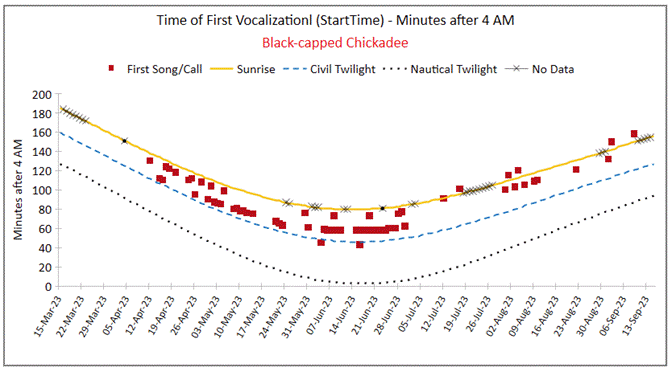

Fig. 15 StartTimes of Black-capped
Chickadee, sunrise, civil and nautical twilights; and number of
participation Quarters, from March 24th and September 9th.
13. Red-winged Blackbird
A male Red-winged Blackbird was vocal
until the end of May and sporadically at sunrise thereafter. Young Red-winged
Blackbirds were seen foraging on the grass in the third week of June.


Fig. 16 StartTimes of Red-winged
Blackbird, sunrise, civil and nautical twilights; and number of
participation Quarters, from March 24th and September 9th.
14. American Goldfinch
American Goldfinches were heard
regularly from July 28th to September 3rd. This species
nests late in the season and participation in the dawn chorus is consistent
with the breeding time.

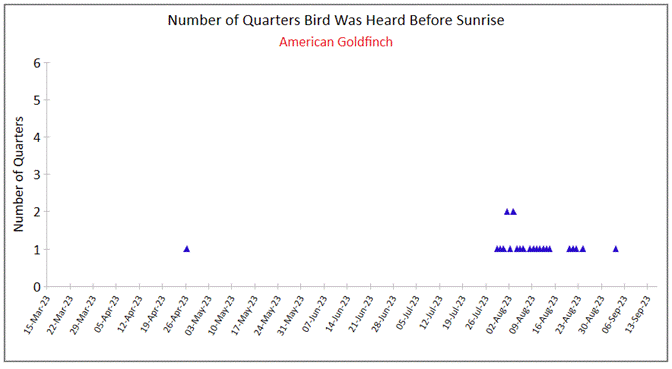
Fig. 17 StartTimes of American
Goldfinch, sunrise, civil and nautical twilights; and number of
participation Quarters, from March 24th and September 9th.
We classify
summer residents as those that arrive from the south in spring and breed here. Migration
continues from late March through mid-May. Species that stop briefly in this
area during migration and breed further north are not included in this study.
There were
15 summer resident species that participated in the dawn chorus. We found confirmed
breeding codes for seven of these species listed in Table 3. In addition, Eastern
Phoebe was probably nesting in the vicinity as one or more birds were seen
regularly. Barn Swallows and Tree Swallows were among the early risers, but
their high-pitched notes in flight were often faint and difficult to validate. Eastern
Kingbird, another species with high pitched songs, was detected well only in
mid-July and young adults were spotted on August 24th. Other species
heard only on a few occasions and are not included.
Table 3 Breeding codes for summer residents participating in the dawn chorus.
1. Chipping Sparrow
Chipping Sparrow arrived on April 1st
and was first heard in the dawn chorus on April 5th. From the
differences in the sound volumes, it was easy to detect that there were at
least two birds singing. Once started, these birds continued singing all
through dawn - typically heard in three or four Quarters in May through
July.
The StartTime was about 20
minutes before sunrise in April and increased to 40 to 50 minutes in May and
June. Singing began soon after the robins and it may be that their singing was
triggered by that of robins. If that is so, no other bird species followed the robins
so consistently. By late July, StartTime reduced to about 30 minutes
before sunrise. These birds stopped participating in the dawn chorus after
August 5th. and at the same time stopped vocalizing during the day
also. Two adults and one juvenile were regularly seen after August 5th,
silently feeding on the ground, and a mixed flock of 20 adults and juveniles was
seen in September.
Two pairs of Chipping Sparrows built
their nests in the Home 'patch', one in the backyard and one in the front yard.
Nest-building began in a Hydrangea vine under the deck on May 1st.
Three Chipping Sparrow eggs and two Brown-headed Cowbird eggs were found in
this nest on May 9th. A second nest was found in the Pencil Holly in
the front yard on May 31st. It had one sparrow egg, one just hatched
chick and one cowbird egg. Chipping Sparrows were last seen carrying food on
July 7th. The breeding season was from May 1st to
mid-July, with possibly two broods.
Their StartTimes appeared to
be independent of the light level but varied more than for robins. The average StartTime
in Fig. 19 is 45 minutes before sunrise and the standard deviation is 6
minutes. Note that a Chipping Sparrow weighs only 12 g and is one of the
smallest bird species in the chorus. It is 1/6th the mass of
American Robin, yet both species began singing at about the same time.


Fig. 18 StartTimes of Chipping
Sparrow, sunrise, civil and nautical twilights; and number of participation
Quarters, from March 24th and September 9th.


Fig. 19 StartTimes
of Chipping Sparrow from sunrise vs. light intensity in Quarters Q1
and Q2. Time for sunrise, shown as orange line, is designated as zero.
2. Baltimore Oriole
A pair of Baltimore
Orioles were first seen in the Home 'patch' on May 8. The male was singing away
during the day, and the female was collecting nesting material. The
participation in dawn chorus was minimal. The male sang only a few times just
around sunrise but was vocal many times during the day.
On June 22nd and June 24th, one
or more fledglings were followed by the parent bringing food.


Fig. 20 StartTimes of Baltimore
Oriole, sunrise, civil and nautical twilights; and number of participation Quarters,
from March 24th and September 9th.
3. Red-eyed Vireo and
4. Yellow Warbler
A Red-eyed Vireo and a female Yellow
Warbler were seen hunting insects in the woods behind my house and then flying
away carrying the catch. There is only one instance of each of these species'
participation in the dawn chorus. Their nests may have been located further
away.
5. Eastern Wood-pewee
Eastern
Wood-pewee announced his arrival by the melodious 'PEEaweee' song
on May 15th. He stayed in the woods and was only occassionally seen,
but his voice reverberated in the woods. His continuous participation in the
dawn chorus began in late July just as other bird species were becoming silent,
and continued through the beginning of September. Fledglings, exhibiting larger
gapes in the bill, were first seen on July 30th.
From the dawn chorus participation, it appears that
the Wood-pewees may have started a second nest close by after their first brood
fledged.

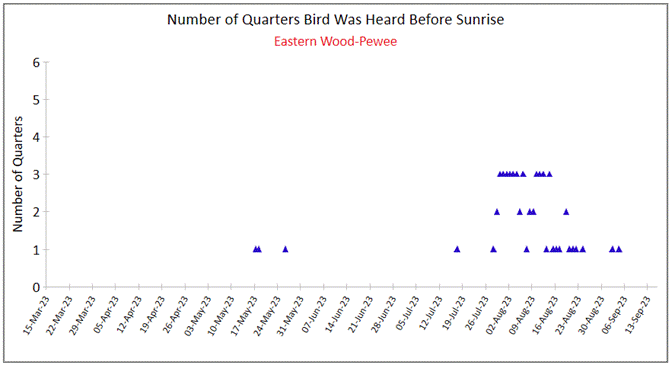
Fig. 21 StartTimes of Eastern
Wood-pewee, sunrise, civil and nautical twilights; and number of
participation Quarters, from March 24th and September 9th.
6. House Wren
One House
Wren was first spotted on April 27th and heard in the dawn chorus on
May 2nd. Participation in the chorus continued until the end of
August, typically in the civil twilight period. Four or more fledglings were
spotted on June 19th.

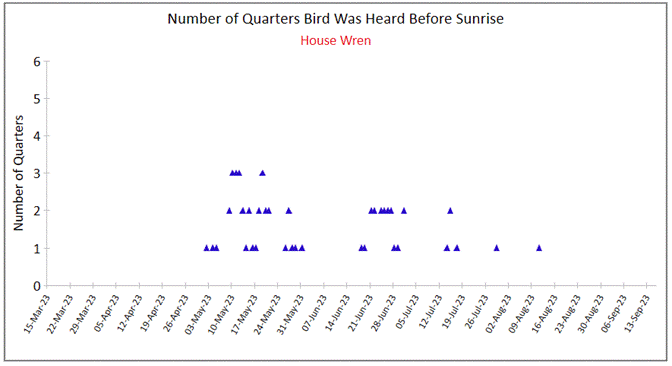
Fig. 22 StartTimes of House
Wren, sunrise, civil and nautical twilights; and number of participation Quarters,
from March 24th and September 9th.
7. Gray Catbird
Gray
Catbirds arrived in the Home 'patch' on May 7th. A pair may have
been nesting in nearby shrubs but the nest was well concealed. A catbird was
seen carrying nesting material on May 17th. Catbird's StartTimes
in the dawn chorus varied, typically in the civil twilight period or just after
sunrise.


Fig. 23 StartTimes of Gray
Catbird, sunrise, civil and nautical twilights; and number of participation
Quarters, from March 24th and September 9th.
8. Eastern Phoebe
An Eastern Phoebe was first spotted
on March 30th and first heard in dawn chorus on April 12th.
He participated regularly until the middle of May and then heard on many days
with gaps in between.


Fig. 24 StartTimes of Eastern
Phoebe, sunrise, civil and nautical twilights; and number of participation Quarters,
from March 24th and September 9th.
Dark-eyed Juncos and White-throated Sparrows are seen
in my Home 'patch' all winter. juncos were singing before sunrise from the time
I started recording on March 24th and continued until April 14th.
These birds were last seen on April 16th before migrating north for
the summer.
White-throated Sparrows were first heard singing at
dawn on April 12th and continued until last seen on May 15th.
During this time, they were also singing after sunrise and occasionally during
the day.
These two bird species do not breed in this area.
Hence, their singing is not related to protecting breeding grounds.
Ruby-crowned Kinglet, another winter resident, was
heard only once on May 16th.
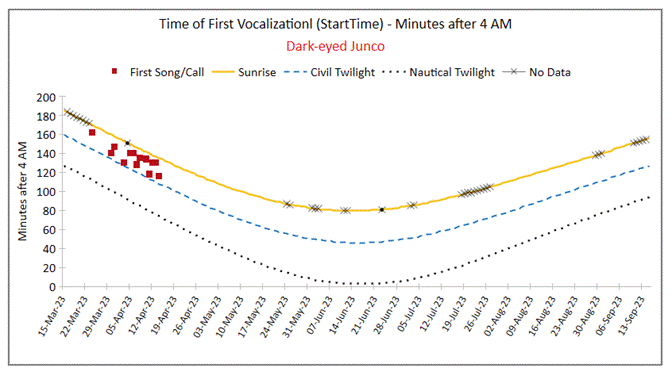

Fig. 25 StartTimes of Dark-eyed
Junco and White-throated Sparrow, sunrise, civil and nautical twilights
from March 24th and September 9th.
StartTimes and participations of several other
species are shown below. These include Mourning Doves, Red-bellied Woodpecker,
Canada Goose and Barred Owl, each belonging to a different order than
songbirds.
1. Mourning Dove
Mourning Doves were regular participants, but the StartTimes with respect to
sunrise were variable.
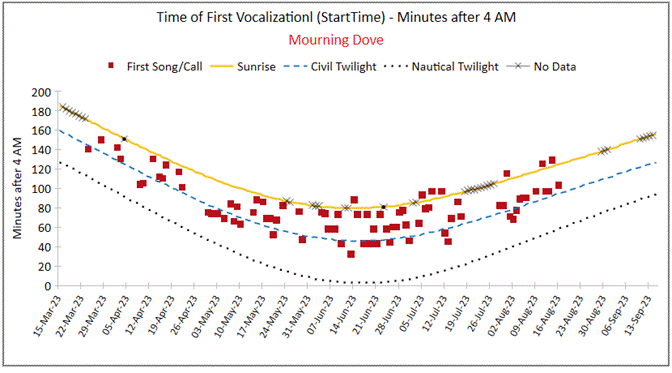

Fig. 26 StartTimes of Mourning
Dove, sunrise, civil and nautical twilights; and number of participation Quarters,
from March 24th and September 9th.
2. Red-bellied Woodpecker
Red-bellied Woodpeckers called around sunrise fairly
regularly between May 7th and May 23rd. These birds do
breed in the vicinity. A juvenile with a bald head was spotted on August 9th.


Fig. 27 StartTimes of Red-bellied
Woodpecker, sunrise, civil and nautical twilights; and number of
participation Quarters, from March 24th and September 9th.
3. Canada Goose
Canada Geese honk in flight as they pass this area
before sunrise. One pair nested near the pond across the street from my house
and goslings were present in the first week of May. The flights were
discontinued in June and July when the geese are molting.


Fig. 28 StartTimes of Canada
Goose, sunrise, civil and nautical twilights; and number of participation Quarters,
from March 24th and September 9th.
4. Barred Owl
Barred Owls typically call at night. In the months of
April and May, one owl was hooting at dawn.
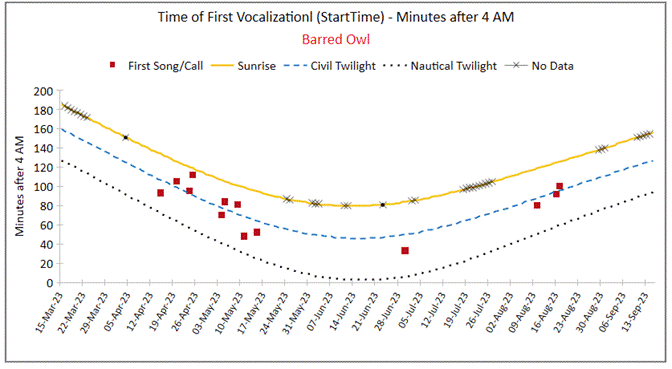

Fig. 29 StartTimes of Barred
Owl, sunrise, civil and nautical twilights; and number of participation Quarters,
from March 24th and September 9th.
In March of
2023, I started listening to birdsongs at dawn to learn more about birds in the
neighborhood and to hone my skills in bird identification by songs. By the end
of the first week, I realized that different bird species vocalized at
different times. Our team member Hemant Sogani who resides in India and I devised
a scheme for recording and analyzing the data and created a database to track
the StartTimes more accurately. As the season progressed, the birds were
starting to sing earlier and earlier and my desire to know how well their StartTimes
tracked with sunrise made me keep up with them.
It was
enlightening to learn how some birds coordinated their singing with nesting,
and ending abruptly when the last brood of the season fledged. Conversely, one
may know of the nesting period of a species by their singing regularity at
dawn.
There is a
saying that "Cocks crow in the morn to tell us to rise, and he who lies late
will never be wise." Fortunately cocks crow just at sunrise when there is
sufficient light, and it is not much of a hardship to wake up then. In this
area some songbirds appear to be much wiser, knowing the time of sunrise an
hour ahead even when there is cloud cover or rain. I, on the other hand,
depended on an alarm clock to wake me up.
I am aware that
if there is no pressure to do otherwise, I am always wide awake just around
sunrise - earlier in summer than in winter. Keeping up with American Robins and
Chipping Sparrows for me was an arduous task. Perhaps I should limit my study to
House Finches next year or switch to listening to dusk chorus.
Dawn and Twilight
Civil,
nautical, and astronomical twilights are defined with the sun at 6o,
12o and 18o below the horizon respectively as illustrated
in Fig. A1.
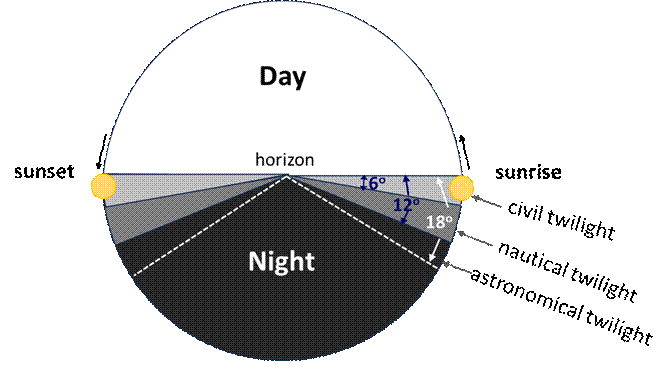
Fig. A1 Position of the
sun at sunrise, and at the onset of civil, nautical, and astronomical
twilights.
Sunrise: Sunrise is the time when the upper rim of
the sun appears on the horizon in the morning.
Civil Twilight:Morning civil twilight begins when the geometric center of
the sun is 6o below the horizon and
ends at sunrise. Evening civil twilight begins
at sunset and ends when the geometric center of the sun is 6 degrees below the
horizon. Under these conditions absent fog or other restrictions, the
brightest stars and planets can be seen, the horizon and terrestrial objects
can be discerned, and in many cases, artificial lighting is not needed.
Nautical Twilight:Begins in the morning, or ends in the evening, when the
geometric center of the sun is 12o
below the horizon. In general, the term nautical twilight refers to
sailors being able to take reliable readings via well-known stars because the
horizon is still visible, even under moonless conditions. Absent fog or
other restrictions, outlines of terrestrial objects may still be discernible,
but detailed outdoor activities are likely curtailed without artificial
illumination.
Astronomical Twilight: Begins in the morning, or ends in the
evening, when the geometric center of the sun is 18o below the horizon. In astronomical
twilight, sky illumination is so faint that most casual observers would regard
the sky as fully dark, especially under urban or suburban light
pollution. The horizon is not discernible and moderately faint stars or
planets can be observed with the naked eye under a non-light polluted
sky. Point light sources such as stars and planets can be readily
studied by astronomers under astronomical twilight but not galaxies, nebula,
and globular clusters.
Dawn: is technically defined as the period
between the start of civil twilight and sunrise.
Sunrise, and onset of civil and
nautical twilight times for Hopewell Junction, NY, USA are plotted below.
Location: Hopewell Junction, NY, USA.
Latitude: 41o35′3″
N, Longitude: 73o48′31″ W
Year: 2023
Time Zones: Eastern Standard Time (EST)
Eastern Daylight Time (EDT) from March 12th,
2023, to November 5th, 2023

Fig. A2 Sunrise and onset of civil and nautical twilight
times in Hopewell Junction, NY, USA for 2023.

Fig. A3 Sunrise and onset of civil and nautical twilight
times in Hopewell Junction, NY, USA from vernal equinox to autumnal equinox.
Time difference in minutes between
sunrise and civil and nautical twilight onset times is shown in Fig. A4. Civil
twilight begins 25 to 32 minutes before sunrise. Nautical twilight begins
between 58 and 78 minutes before sunrise.

Fig. A4 Time difference (in minutes) between sunrise and
onset of civil and nautical twilights.
Light
intensity was recorded in each Quarter using a light meter (Dr.meter
model LX1330B) with a resolution of 0.1 Lux and a measurement accuracy of +/- 3%.
This standard light meter measures incident light, wavelength-weighted by the
luminosity function defined as the average spectral sensitivity of human visual
perception for brightness. Different bird species and individual birds within a
species may perceive brightness differently - an unknown factor.
The sensor was
held in a vertical position against a windowpane facing part of the sky and
trees. There were no artificial lights in the vicinity, but scattered city
lights had some influence on the pre-dawn brightness.

Fig. A5 Measured light
intensity in each Quarter before and after sunrise.
Figure A5
shows the light intensity measured once in each Quarter each day. The
dashed lines are hand drawn to indicate the maximum light intensity before
sunrise. The increase in light intensity with time before sunrise is
exponential, the slope decreases after sunrise. Clouds, rain, haze and fog may
reduce the light level in a Quarter by as much as a factor of 20. The
light intensity in Q5 and Q4 was < 0.1 Lux and not detected by
the meter. The first measurement of the day was made in Q3 (30 to 45
minutes before sunrise) when the light intensity was in the 0.1 to 1.0 Lux
range.
Figure A6
illustrates how the light intensity levels in Q1 and Q2 track
with Q3 on three days with different sky conditions. On clear and cloudy
days, the tracking is good and the intensity at Q4 is extrapolated to
≤ 0.1 Lux. During a rainstorm, the light intensity may be more variable
at dawn as the rain and cloud cover change over time.

Fig. A6 Measured light
intensity in Q1, Q2 and Q3 on three days with different sky conditions: 1)
clear, 2) cloudy, 3) rain.
Light intensity on a clear moonless night is reported> to be 0.002 Lux, 0.05 Lux on a full moon night and 3.5 Lux at the onset
of civil twilight on a clear new moon night. The highest measured intensity in Q2,
8 minutes after the onset of civil twilight on July 31st with a full
moon, was 18 Lux. Using the slope of the red line of June 19th in
Fig. A6, the maximum light intensity at the onset of civil twilight is then 7.7
Lux, twice the reported value. Also, from the slope of this line we can deduce
that a 16X change in Q2 light intensity would have shifted the StartTime
of a robin by 17 minutes, if the singing were triggered by light intensity as
measured by the light meter. However, as shown in Fig. 6 (reproduced below),
the StartTime of a robin remained 52 +/- 3 minutes as the light intensity in
Q2 changed from 1.0 Lux to 16.2 Lux.

Fig. 6 StartTimes
of American Robin from sunrise vs. light intensity in Quarter Q2.
Time for sunrise, shown as orange line, is designated as zero.
Songbirds participating in the dawn chorus; resident
term, body mass, total number of Quarters and first and last dates heard
are listed in Table 4.
Table 4 Songbirds participating in dawn
chorus from March 24th, 2023 to September 9th, 2023. Note
resident term abbreviations: A = All year, S = Summer, W = Winter
| |
Species |
Resident Term |
Body Mass
(g) |
# of Quarters Heard |
First Heard |
Last Heard |
| 1 |
American Robin |
A |
77 |
461 |
24-Mar |
9-Sep |
| 2 |
Northern Cardinal |
A |
45 |
405 |
24-Mar |
9-Sep |
| 3 |
Carolina Wren |
A |
21 |
177 |
24-Mar |
8-Sep |
| 4 |
Tufted Titmouse |
A |
21.5 |
146 |
27-Mar |
26-Aug |
| 5 |
House Finch |
A |
21.1 |
119 |
27-Mar |
4-Aug |
| 6 |
Black-capped Chickadee |
A |
11 |
96 |
12-Apr |
9-Sep |
| 7 |
Blue Jay |
A |
85 |
81 |
10-Apr |
9-Sep |
| 8 |
White-breasted Nuthatch |
A |
21.2 |
60 |
18-Apr |
9-Sep |
| 9 |
American Goldfinch |
A |
13 |
49 |
26-Apr |
3-Sep |
| 10 |
American Crow |
A |
450 |
45 |
29-Mar |
12-Aug |
| 11 |
Song Sparrow |
A |
20.1 |
38 |
25-Mar |
10-Jun |
| 12 |
Eastern Bluebird |
A |
31 |
31 |
31-Mar |
7-Sep |
| 13 |
Red-winged Blackbird |
A |
52 |
25 |
3-Apr |
4-Aug |
| 14 |
Northern Mockingbird |
A |
49 |
11 |
13-Jun |
2-Sep |
| 15 |
Common Grackle |
A |
115 |
10 |
16-Apr |
14-Jul |
| 16 |
Fish Crow |
A |
280 |
4 |
26-May |
18-Jun |
| 17 |
House Sparrow |
A |
28 |
2 |
15-Apr |
1-Aug |
| 18 |
European Starling |
A |
82 |
1 |
28-May |
28-May |
| 19 |
Brown-headed Cowbird |
A |
44 |
1 |
21-May |
21-May |
| 20 |
Chipping Sparrow |
S |
12 |
339 |
-Apr |
5-Aug |
| 21 |
Eastern Wood-Pewee |
S |
14 |
87 |
17-May |
4-Sep |
| 22 |
House Wren |
S |
11.1 |
77 |
2-May |
22-Aug |
| 23 |
Gray Catbird |
S |
37 |
75 |
9-May |
9-Sep |
| 24 |
Eastern Phoebe |
S |
20 |
48 |
12-Apr |
2-Sep |
| 25 |
Baltimore Oriole |
S |
33 |
9 |
11-May |
21-Aug |
| 26 |
Barn Swallow |
S |
19 |
9 |
22-May |
21-Aug |
| 27 |
Eastern Kingbird |
S |
40 |
7 |
28-Jun |
30-Jul |
| 28 |
Great Crested Flycatcher |
S |
34 |
6 |
31-May |
14-Aug |
| 29 |
Warbling Vireo |
S |
12 |
3 |
21-Jun |
24-Jun |
| 30 |
Red-eyed Vireo |
S |
17 |
2 |
17-Jun |
18-Jun |
| 31 |
Tree Swallow |
S |
20.2 |
2 |
8-May |
21-May |
| 32 |
Yellow Warbler |
S |
9.5 |
1 |
17-Jun |
17-Jun |
| 33 |
Eastern Towhee |
S |
40 |
1 |
30-Apr |
30-Apr |
| 34 |
Wood Thrush |
S |
47 |
1 |
1-Aug |
1-Aug |
| 35 |
White-throated Sparrow |
W |
26 |
20 |
12-Apr |
15-May |
| 36 |
Dark-eyed Junco |
W |
19.1 |
13 |
24-Mar |
14-Apr |
| 37 |
Ruby-crowned Kinglet |
W |
6.5 |
1 |
16-May |
16-May |
We thank Dr. Mark B. Ketchen for carefully reviewing
the data analysis and for making valuable comments on the manuscript.
1. Horace W. Wright
(1913) "Morning Awakening and Even-song" The Auk , Oct., 1913, Vol. 30, No. 4
(Oct., 1913), pp. 512-537. https://www.jstor.org/stable/4072050
2. Kroodsma Donald (2020)
"Energized Dawn Singing" in 'Birdsong for the Curious Naturalist', Chapter 7, Houghton
Miffliin Harcourt Publishers, pp 112-123.
3. Diego Gil and Diego
Llusia (2020) "The Bird Dawn Chorus Revisited", Chapter 3 in 'Coding
Strategies in Vertebrate Acoustic Communication', Springer.
4. Thomas Robert J. et.
al. (2002) "Eye size in birds and the timing of song at dawn" Proc. Royal
Society London, vol 269, pp. 831-837.
5. Miller Mark W. (2006)
"Apparent effects of light pollution on singing behavior of American Robins"
The Condor vol.108, pp 130-139.
6. Bruni A. et. al.
(2014) "Dawn chorus start time variation in a temperate bird community:
relationships with seasonality, weather and ambient light" J. Ornithology,
155:877-890.




























































